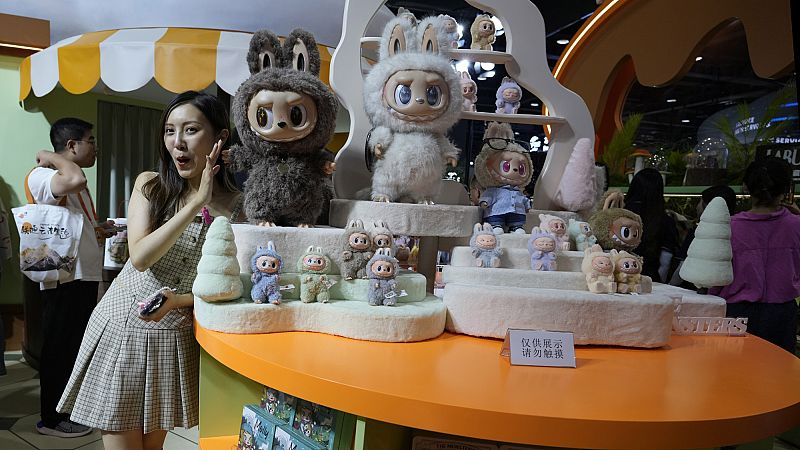Economic modelling may not seem like a TikTok-friendly subject. But as young people feel the pinch of low growth on their wallets, so-called “recession indicators” are sparking conversations among Gen Z. According to Google Trends, searches for “recession indicators” spiked over the summer. A quick glance at TikTok also reveals a good deal of unusual macro forecasting. While serious economists may shrug off such theories, is there any truth behind the hype?
If you’re spending any time online, you may have noticed that Labubu toys, monster-like plush dolls, are the new must-have item — generally selling for under €30. You may also have seen that minimalist beauty trends are taking off, replacing maximalist designs on certain corners of the internet. In the eyes of some, the sudden rush for affordable treats is a bad sign, pointing to economic malaise as consumers cut back on bigger purchases.
But #RecessionIndicators isn’t new; it’s really a TikTok take on much older theories. For example, if we look back to the early noughties, we can see how Leonard Lauder of cosmetics giant Estée Lauder popularised the so-called ‘Lipstick Index’. The reasoning here is the same. During economic downturns, Lauder claimed that consumers search for affordable luxuries, one of these being lipstick.
The Men’s Underwear Index, famously watched by former Federal Reserve head Alan Greenspan, is another similar idea. Greenspan argued that during times of hardship, men are more likely to forgo buying new underwear and hold on to their old boxers. When the economy improves, he said men are more likely to purchase replacements.
Related
“What is absolutely accurate is that when people hit recessions, when they are hard up for money, they do look for smaller, affordable treats,” said Cathrine Jansson-Boyd, professor of consumer psychology at Anglia Ruskin University.
“But these indicators are limited,” she added. This is because looking at a specific item may only cover a certain segment of the population — for instance those interested in buying lipstick.
Even so, it’s a clever move for brands to focus on the state of the economy and market their products accordingly, said Jansson-Boyd.
“Lots of brands are very aware of this, which is why they will launch more new ranges with smaller items when things get a bit tougher on the market,” she said. “It also often appeals to younger audiences who can then become brandy-savvy and loyal at an early age.”
Companies may also change their advertising techniques during times of financial stress to appeal to consumers in a different way.
Aside from the Lipstick Index, another ‘recession indicator’ that gets a lot of airtime is the Hemline Index. Allegedly created by the economist George Taylor in 1926, the theory suggests that skirts are shorter during times of financial prosperity, and they become longer during a recession. One reason? During economic booms, women are arguably more likely to purchase luxury stockings and want to show them off (at least in the early to mid 20th century).
Despite the interest the theory has attracted, it remains an “urban legend”, said Philip Hans Franses, professor of applied econometrics at Erasmus School of Economics.
Franses, together with his student Marjolein Baardwijk, studied old editions of L’Officiel, a French fashion magazine that dates back to the 1920s. When comparing skirt lengths with data on recessions, they found there was no strong correlation between the two.
He told Euronews: “The only thing that could be found, but it’s very weak, is that perhaps there is some lag effect. So if the economy is doing well now, it may have a small impact on skirt length three years from now.” Franses added that the reasons for this are unclear and stressed there isn’t a strong correlation.
When it comes to unconventional ‘recession indicators’ like underwear purchases, or even music trends, Franses told Euronews that there generally isn’t enough data to make the claims more than anecdotal.
“Measuring recessions, let alone predicting them, is very tricky,” Andrew Kenningham, chief Europe economist at Capital Economics, told Euronews.
“Even the definition varies,” he explained. “In the US, the National Bureau for Economic Research has its own methodology for determining whether a recession has occurred. For most other developed economies there is no official measure but the convention is that two successive quarters of contracting GDP constitute a recession.”
There is — however — no one ideal indicator, as this approach can label slower, more mild contractions as a recession, all while missing sharper, shorter downturns.
Related
Other metrics used by economists include monthly business surveys such as Purchasing Managers’ Surveys and the EC Economic Sentiment Indictor (ESI). These track levels of financial confidence among different groups.
Another “less colourful” economic indicator is the inverted yield curve, said Sebastian Franke, consumer economist with ING.
“Long-term bond yields are usually higher than those for the short term. If the opposite is true, this suggests that market participants are expecting lower interest rates in the future, which usually result from slower growth,” he told Euronews.
While there may be glimmers of truth in TikTok’s ‘recession indicators’, they can’t be placed on the same level as these more serious metrics. Instead, they are what Franses termed a “Friday afternoon interest” — a bit of fun.
“They also did this in medieval times,” he told Euronews. “People looked for phenomena and attached meaning to trends.”
In conclusion, #RecessionIndicators is certainly older than TikTok.



Leave a Comment
Your email address will not be published. Required fields are marked *